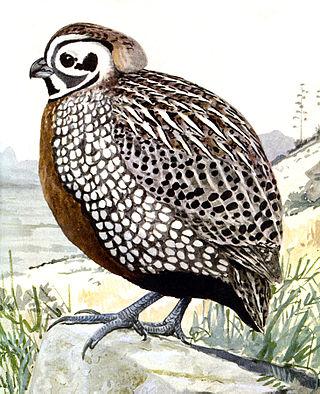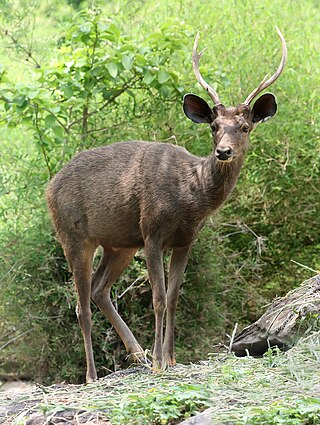
In biological cladistics for the classification of organisms, monophyly is the condition of a taxonomic grouping being a clade – that is, a grouping of taxa which meets these criteria:
- the grouping contains its own most recent common ancestor, i.e. excludes non-descendants of that common ancestor
- the grouping contains all the descendants of that common ancestor, without exception

Weasels are mammals of the genus Mustela of the family Mustelidae. The genus Mustela includes the least weasels, polecats, stoats, ferrets, and European mink. Members of this genus are small, active predators, with long and slender bodies and short legs. The family Mustelidae, or mustelids, is often referred to as the "weasel family". In the UK, the term "weasel" usually refers to the smallest species, the least weasel (M. nivalis), the smallest carnivoran species.

In taxonomy, binomial nomenclature, also called binary nomenclature, is a formal system of naming species of living things by giving each a name composed of two parts, both of which use Latin grammatical forms, although they can be based on words from other languages. Such a name is called a binomial name, a binomen, binominal name, or a scientific name; more informally it is also historically called a Latin name. In the International Code of Zoological Nomenclature (ICZN), the system is also called binominal nomenclature, with an "n" before the "al" in "binominal", which is not a typographic error, meaning "two-name naming system".

The four species of avocets are a genus, Recurvirostra, of waders in the same avian family as the stilts. The genus name comes from Latin recurvus, 'curved backwards' and rostrum, 'bill'. The common name is thought to derive from the Italian (Ferrarese) word avosetta. Francis Willughby in 1678 noted it as the "Avosetta of the Italians".

The common sandpiper is a small Palearctic wader. This bird and its American sister species, the spotted sandpiper, make up the genus Actitis. They are parapatric and replace each other geographically; stray birds of either species may settle down with breeders of the other and hybridize. Hybridization has also been reported between the common sandpiper and the green sandpiper, a basal species of the closely related genus Tringa.

Tragelaphus is a genus of medium-to-large-sized spiral-horned antelopes. It contains several species of bovines, all of which are relatively antelope-like. Species in this genus tend to be large in size and lightly built, and have long necks and considerable sexual dimorphism. Elands, including the common eland, are embedded within this genus, meaning that Taurotragus must be subsumed into Tragelaphus to avoid paraphyly. Alternatively, Taurotragus could be maintained as a separate genus, if the nyala and the lesser kudu are relocated to their own monospecific genera, respectively Nyala and Ammelaphus. Other generic synonyms include Strepsiceros and Boocercus. The name "Tragelaphus" comes from the mythical tragelaph.

The Syngnathidae is a family of fish which includes seahorses, pipefishes, and seadragons. The name is derived from Ancient Greek: σύν, meaning "together", and γνάθος, meaning "jaw". The fused jaw is one of the traits that the entire family have in common.
The abbreviation cf. is used in writing to refer the reader to other material to make a comparison with the topic being discussed. Style guides recommend that "cf." be used only to suggest a comparison, and the words "see" or "vide" be used generally to point to a source of information. In Italian, the abbreviation "cfr." is more common than "cf." is.

Acacia, commonly known as wattles or acacias, is a genus of about 1,084 species of shrubs and trees in the subfamily Mimosoideae of the pea family Fabaceae. Initially, it comprised a group of plant species native to Africa, South America, and Australasia, but is now reserved for species mainly from Australia, with others from New Guinea, Southeast Asia, and the Indian Ocean. The genus name is Neo-Latin, borrowed from the Greek ἀκακία, a term used in antiquity to describe a preparation extracted from Vachellia nilotica, the original type species.

Cyrtonyx is a bird genus in the New World quail family Odontophoridae.

Rusa is a genus of deer from southern Asia. They have traditionally been included in Cervus, and genetic evidence suggests this may be more appropriate than their present placement in a separate genus.
Osmakasaurus is a genus of herbivorous iguanodontian dinosaur. It is a basal iguanodontian which lived during the Early Cretaceous period in what is now Buffalo Gap of South Dakota, United States. It is known from the Chilson Member of the Lakota Formation. This genus was named by Andrew T. McDonald in 2011 and the type species is O. depressus.
Enneacampus kaupi is a pipefish in the family Syngnathidae. It is found in Africa, from Liberia to the Congo River estuary. It lives in fresh and brackish water estuaries and streams where it is usually found among algae at depths of 10–13 m. Its IUCN status is Least Concern. Wild-caught members of this species can be found in the aquarium trade. The specific name honours the ichthyologist Johann Jakob Kaup.
Cephalofovea is a genus of velvet worms in the Peripatopsidae family. All species in this genus are ovoviviparous and have 15 pairs of oncopods (legs), and both sexes possess a pitted-head which the male everts and uses to pass his spermatophore to the female. They are found in New South Wales, Australia.

Thomas's big-eared brown bat is a species of vesper bat found in South America.

Cheracebus is one of three genera of titi monkeys. Monkeys in this genus, particularly the type species Cheracebus lugens, are sometimes referred to as widow titi monkeys.

Aquilarhinus is a genus of hadrosaurid ornithopod dinosaur from the Aguja Formation from Texas in the United States. The type and only species is Aquilarhinus palimentus. Due to its unusual dentary, it has been inferred to have had shovel-like beak morphology, different from the beaks of other hadrosaurs. It was originally classified as a Kritosaurus sp. before being reclassified as a new genus in 2019.
Musivavis is a genus of euenantiornithine bird from the Early Cretaceous (Aptian) Jiufotang Formation of Liaoning Province, China. The genus contains a single species, Musivavis amabilis, known from a nearly complete, articulated skeleton.

Paralitherizinosaurus is an extinct genus of therizinosaurid dinosaur from the Late Cretaceous Osoushinai Formation of Hokkaido, Japan. The genus contains a single species, P. japonicus, known from a partial right hand and cervical vertebra. Paralitherizinosaurus represents the youngest therizinosaur known from Japan.

Cratonavis is an extinct genus of pygostylian avialian from the Early Cretaceous Jiufotang Formation of Liaoning Province, China. The genus contains a single species, C. zhui, known from a complete skeleton.














